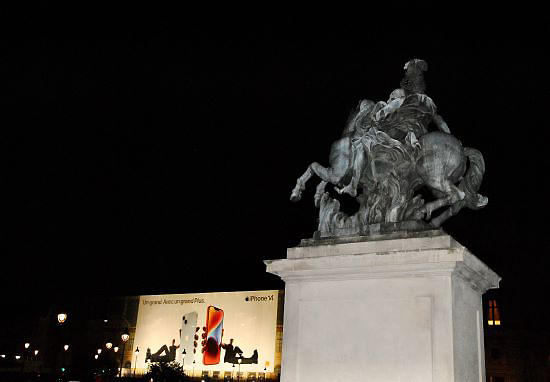 | Claude Abron
|
Palais-Royal, where the ideas of Liberty, Equality, Fraternity took wing.
A 19th-century reconstruction. For images from the time, please click.
Execution of the Templars (cropped), anonymous, 15th century / zoom
This typical illustration shows the king looking on, riding a white horse.
Claude Abron
The Saint-Denis gate
2.4. VISITS WITH CHILDREN (OR WITHOUT THEM)
Facing the medieval Cemetery of the Holy Innocents and its descendant,
Europe's most important center for boys' casual clothes.
Philip of France in Costume of Antiquity by Jean Nocret, toward 1650 / zoom
Louis XIV's younger brother dressed as a Roman general
The backers' private salon is decorated by an orgy. Guides skip it. Few visitors notice.
2.8. FROM NYMPHS TO NAZIS, HOW OPERA GIRLS SAVED THE CITY
A giant puppet in a parade on the northern fringe
French residents observe a Chinese New Year celebration.

.jpg)
Illustration by Maurice Leloir in Le Roy Soleil, a history book for children, 1931 | Louis XIV's royal entry trumpets tougher monarchy by passing
father's and grandfather's innovations.
|
Claude Abron: photo taken from a helicopter
The line that stretches from palace to horizon symbolizes endless power.
Louis XIV in the courtyard of the Louvre, and the kind of ad that hovers over the city since 2011
HOW FEAR OF INSURRECTION BROADENED THE BEAUTY THE KINGS BEGAN
A passage built to let the army invade blue-collar territory
The Barricade of Rue de la Mortellerie, June 1848 by Ernest Meissonnier / zoom Painting from a sketch made on the spot.
Proclamation of La Commune, March 26 1871, anonymous engraving / zoom
La Commune acclaimed at City Hall
The Call by André Devambez, 1906, based on the memories of his father and survivors / zoom
Women meet during La Commune.
The long, wide, straight street was built after the insurrection of June 1848 so that troops move arrive quickly to quell a future revolt. It also draws the eye to a church, which preached obedience in what was then the city's poorest district.
Leftist posters at the Olympiades métro, 13th.
Paris's May Day parade begins in front of the 13th's City Hall.
Plaque commemorating the site where a fighter for the Liberation of Paris was killed.
# # #
* * *
shows how placing events in their economic contexts can transform their meanings and gives a reason for the omissions mentioned here. |
|









.JPG)




.jpg)






.jpg)

.jpg)





1 comment:
Your breath of subject matter is well, breath taking! I am puzzling over your market for your life time of learning and critical thinking. This is not for the causual visitor to France. I do see that any serious student of France should find a place on their self for this work. Tour guide with a Ph.D. in history from Columbia....you are a most unusual tour guide; you are a guide to deeper thought and pondering. I move on to the next section, intrigued. Are you sure you did not major in economics?
Post a Comment